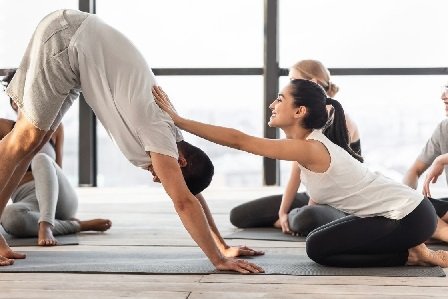Yoga is a great way to improve physical, mental, and emotional well-being. Taking part in a yoga class for the first time can be intimidating, but it becomes an enjoyable and rewarding experience with a few tips and preparation.
Doing some research before attending a yoga class for the first time is important. Learn about the different types of yoga classes available and their difficulty level. This will help you find a class suitable for your fitness and personal goals.
What is yoga?
Yoga has been a holistic practice for centuries to promote physical, mental, and spiritual well-being. It combines physical postures, breathing techniques, and meditation or relaxation to strengthen the body and mind.
Regular practice can increase endurance, strength, calmness, flexibility, and well-being. Yoga is now widely practiced worldwide and is estimated to be used by one in seven adults in the United States.
There are six main branches of yoga, including Hatha, Raja, Karma, Bhakti, Jnana, and Tantra, each with its purpose and goals.
What impact does yoga have on our bodies?
Yoga has proven to have both mental and physical benefits, and they include,
1. Improves strength, balance, and flexibility
Through engaging the core muscles and stretching the body, yoga helps to build strength and improve posture. It improves balance and coordination by targeting muscles that traditional workout routines would otherwise neglect. Yoga also improves flexibility by extending and stretching the muscles, which enables the body to move in ways it previously might not have been able to.
2. Helps sleep better
Good quality sleep is essential for physical and mental health. Yoga can help to improve sleep quality by reducing stress and anxiety, calming the mind and body, and helping to relax the nervous system. It also helps to reduce pain and stiffness in the body, allowing for more restful sleep.
3. Helps manage stress, depression, and other mental health conditions
Research indicates that regular yoga practice can help to improve mood, increase resilience to stress, reduce tension, and promote overall psychological well-being. These benefits are attributed to physical exercise, controlled breathing, and meditation, which help lessen the body’s reaction to stress.
Human growth hormone (HGH) helps regulate growth and development. When there is a deficiency of HGH, this can cause a variety of mental health issues such as depression, anxiety, and stress.
HGH deficiency can also affect a person’s libido, causing them to experience a decrease in sexual desire. Fortunately, treatments are available to help restore HGH levels in the body and reduce the symptoms of mental health conditions. One such treatment is Norditropin for sale, an injectable medication that helps increase HGH levels in the body.
4. Benefits heart health
Yoga benefits heart health by reducing stress levels, improving breathing, strengthening the cardiovascular system, and aiding circulation. Stress reduction helps lower the risk of heart disease, while improved breathing brings more oxygen to the body and maintains a healthy heart.
Additionally, increasing cardiovascular endurance through yoga helps strengthen the heart, lowering blood pressure and improving circulation. This reduces the risk of stroke and other cardiovascular events.
5. Ease arthritis symptoms
The gentle stretching, strengthening, and balancing exercises help to reduce pain, stiffness, and inflammation in the joints and muscles. Relaxation techniques employed in yoga, such as deep breathing and guided imagery, help to reduce tension and anxiety, which contribute to the symptoms of arthritis.
Light tips for yoga classes
1. Prepare comfortable and available clothes.
When attending a yoga class, wearing comfortable, breathable clothing that allows you to move freely is important. Choose fabrics such as cotton, lycra, or bamboo, and avoid clothing that is too tight or restrictive.
Also, ensure your clothing is tight enough, as it can distract you. Consider the studio environment and temperature when selecting your clothing.
2. Make sure you have a bottle of water, a hand towel, and a mat
A bottle of water, a hand towel, and a yoga mat are essential for your yoga practice. Staying hydrated is key to getting the most out of your practice. The hand towel is great for wiping off sweat during your practice, and the mat will help you stay comfortable and secure during the class.
3. Prepare your body and avoid heavy meals.
Stretching and warming up your body before a yoga class helps prepare your muscles and joints for the poses and movements you will be doing. Additionally, avoiding heavy meals before a yoga class is important as they can make you feel sluggish and weighed down. Eating lighter meals such as fruits, vegetables, and lean proteins energize your body and allows you to make the most out of your yoga class.
4. Bring a positive mood with yourself.
Having a positive outlook and an open mind is important when practicing yoga. This creates the optimal environment to maximize the benefits of the practice. Bringing mindfulness and self-care to each class allows for the best possible experience.
5. Follow the guide of your yoga teacher.
Your yoga teacher is there to guide you throughout your practice and to make sure you are doing the poses correctly. It is important to listen to their instructions and follow their guidance.
Conclusion
Yoga is a fantastic approach to enhancing one’s physical, psychological, and emotional well-being. The first time you attend a yoga class can be scary, but with some planning, research, and advice, it can be a positive and fulfilling experience. Having a good outlook and paying attention to your yoga teacher’s instructions are also crucial for getting the most out of your practice.
Read Other Stories Loved by Our Users – What You Should Know About Baby Powder Cancer lawsuit?






































